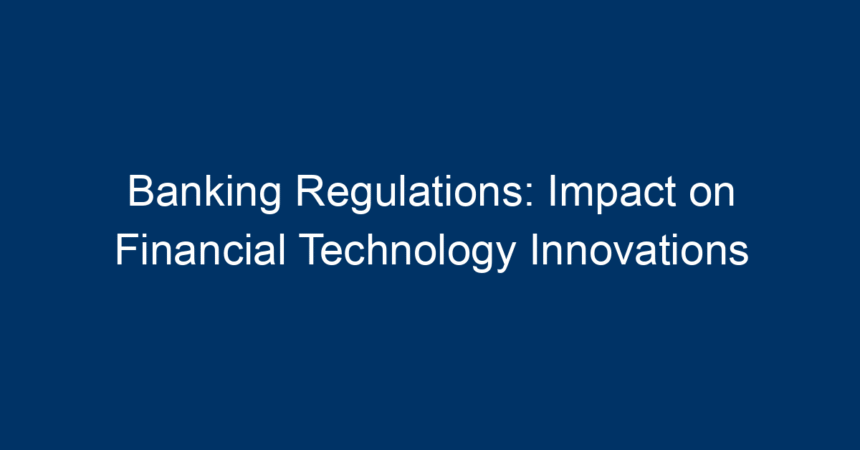In the ever-evolving landscape of finance, few topics generate as much discussion as banking regulations and their impact on financial technology (fintech) innovations. These regulations, while designed to protect consumers and ensure the stability of the financial system, often present challenges and opportunities for fintech companies striving for growth and innovation. In this article, we’ll explore how banking regulations shape the fintech world and what it means for consumers, businesses, and the future of finance.
Understanding Banking Regulations
What Are Banking Regulations?
Banking regulations are laws and guidelines created by governmental and regulatory bodies to oversee the operations of financial institutions. Their primary aims include:
- Consumer Protection: Ensuring banks and fintechs operate transparently and ethically.
- Financial Stability: Preventing systemic risks that might lead to economic crises.
- Compliance: Mandating that banks and fintechs adhere to certain standards for reporting and operational processes.
Common regulatory bodies include the Federal Reserve in the U.S., the Financial Conduct Authority (FCA) in the UK, and the European Central Bank (ECB) in Europe.
Types of Banking Regulations
-
Capital Requirements: Regulations that set the minimum amount of capital a bank must maintain to ensure its financial stability.
-
Consumer Protection Laws: These laws include the Truth in Lending Act (TILA) and the Fair Credit Reporting Act (FCRA), which safeguard consumers from unethical practices.
-
Anti-Money Laundering (AML) Regulations: Rules requiring banks and fintechs to monitor transactions for suspicious activities to prevent money laundering.
- Data Privacy and Security: Laws like the General Data Protection Regulation (GDPR) that dictate how financial institutions must handle consumer data.
The Intersection of Banking Regulations and Fintech Innovations
Regulatory Challenges Faced by Fintech Companies
As players in the fintech arena strive to introduce groundbreaking solutions, they encounter various regulatory hurdles:
-
Compliance Costs: Adhering to stringent regulations often requires significant resources, diverting funds from innovation to compliance efforts.
-
Restrictions on Offerings: Some fintech services, particularly those related to lending and payments, may face limitations that traditional banks do not, affecting their scalability.
- Licensing and Approval Delays: Gaining access to banking licenses or modifications in services can be a time-consuming process, hindering swift market entry.
Opportunities Presented by Regulations
Despite the challenges, banking regulations can also create opportunities for fintech innovations:
-
Consumer Trust: Compliance with regulations fosters consumer confidence, leading to greater adoption of fintech solutions.
-
Collaboration with Traditional Banks: Regulations often encourage partnerships between fintechs and established banks, facilitating innovation through shared expertise and resources.
- Regulatory Technology (RegTech): The need for compliance has given rise to RegTech companies that develop tech solutions specifically for regulatory needs, enhancing efficiency in compliance processes.
The Impact of Banking Regulations on Fintech Innovations
Product Development and Innovation
Banking regulations profoundly affect how fintech companies develop products. For instance, compliance with KYC (Know Your Customer) and AML can result in more sophisticated identity verification solutions. Innovative technologies like artificial intelligence (AI) and machine learning (ML) are deployed not just for product enhancement, but also for meeting these regulatory demands.
Market Competition
Regulations often create a competitive disadvantage for smaller fintech companies compared to larger financial institutions that have more resources to absorb compliance costs. However, there is an emerging trend where regulators are promoting a level playing field, encouraging competition among diverse-sized firms.
Customer Experience
Regulations mandate transparency, which can enhance customer experience. Fintech companies often embrace these regulations to provide clearer terms and conditions, improving overall service delivery. For example, automated platforms that disclose fees upfront can provide users with an informed choice, aligning with consumer protection laws.
The Future Landscape: Banking Regulations and Fintech
Evolution of Regtech
As the fintech space continues to evolve, regulatory technology (RegTech) is poised to become increasingly vital. By simplifying compliance processes and utilizing advanced technologies, RegTech can help fintech companies reduce costs and focus on innovation.
Regulatory Sandboxes
Many countries have adopted regulatory sandboxes—limited environments where fintech startups can test their products without the full burden of compliance. This flexibility fosters innovation while maintaining consumer protection, helping new ideas to flourish.
Collaboration for Better Regulation
The partnership between fintech companies and regulatory bodies is crucial for the sustainable growth of the industry. Ongoing dialogue can lead to adaptive regulations that accommodate rapid technological advancements.
Actionable Insights for Fintech Companies
-
Stay Informed: Regularly update your knowledge on emerging regulations to ensure compliance and leverage opportunities effectively.
-
Invest in RegTech: Consider bringing on RegTech solutions to streamline regulatory processes, which can alleviate burdens on your innovation efforts.
-
Foster a Compliance Culture: Create a culture within your organization that prioritizes compliance, ensuring that all team members understand its importance in sustaining your services.
-
Engage with Regulators: Foster relationships with regulatory bodies to advocate for balanced regulations that promote innovation while protecting consumers.
- Be Consumer-Centric: Focus on delivering transparency and value in your offerings, which can build trust and loyalty in a regulated environment.
Conclusion
In conclusion, banking regulations significantly influence the trajectory of financial technology innovations. Navigating this complex landscape requires awareness, adaptability, and strategic thinking. While the regulations present challenges, they also pave the way for innovative solutions, ultimately benefiting consumers and enhancing the overall financial ecosystem.
By understanding the interplay between banking regulations and fintech innovations, companies can position themselves at the forefront of this dynamic industry, turning regulatory constraints into catalysts for innovation and growth.




